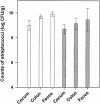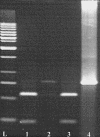Marker rescue studies of the transfer of recombinant DNA to Streptococcus gordonii in vitro, in foods and gnotobiotic rats
- PMID: 14532070
- PMCID: PMC201193
- DOI: 10.1128/AEM.69.10.6121-6127.2003
Marker rescue studies of the transfer of recombinant DNA to Streptococcus gordonii in vitro, in foods and gnotobiotic rats
Abstract
A plasmid marker rescue system based on restoration of the nptII gene was established in Streptococcus gordonii to study the transfer of bacterial and transgenic plant DNA by transformation. In vitro studies revealed that the marker rescue efficiency depends on the type of donor DNA. Plasmid and chromosomal DNA of bacteria as well as DNA of transgenic potatoes were transferred with efficiencies ranging from 8.1 x 10(-6) to 5.8 x 10(-7) transformants per nptII gene. Using a 792-bp amplification product of nptII the efficiency was strongly decreased (9.8 x 10(-9)). In blood sausage, marker rescue using plasmid DNA was detectable (7.9 x 10(-10)), whereas in milk heat-inactivated horse serum (HHS) had to be added to obtain an efficiency of 2.7 x 10(-11). No marker rescue was detected in extracts of transgenic potatoes despite addition of HHS. In vivo transformation of S. gordonii LTH 5597 was studied in monoassociated rats by using plasmid DNA. No marker rescue could be detected in vivo, although transformation was detected in the presence of saliva and fecal samples supplemented with HHS. It was also shown that plasmid DNA persists in rat saliva permitting transformation for up to 6 h of incubation. It is suggested that the lack of marker rescue is due to the absence of competence-stimulating factors such as serum proteins in rat saliva.
Figures





Similar articles
-
Construction of a marker rescue system in Bacillus subtilis for detection of horizontal gene transfer in food.Syst Appl Microbiol. 2002 Dec;25(4):471-7. doi: 10.1078/07232020260517580. Syst Appl Microbiol. 2002. PMID: 12583705
-
Detection of nptII (kanamycin resistance) genes in genomes of transgenic plants by marker-rescue transformation.Mol Gen Genet. 1998 Apr;257(6):606-13. doi: 10.1007/s004380050688. Mol Gen Genet. 1998. PMID: 9604883
-
Effect of food processing on the fate of DNA with regard to degradation and transformation capability in Bacillus subtilis.Syst Appl Microbiol. 2003 Nov;26(4):495-501. doi: 10.1078/072320203770865774. Syst Appl Microbiol. 2003. PMID: 14666975
-
Human safety and genetically modified plants: a review of antibiotic resistance markers and future transformation selection technologies.J Appl Microbiol. 2005;99(1):7-23. doi: 10.1111/j.1365-2672.2005.02595.x. J Appl Microbiol. 2005. PMID: 15960661 Review. No abstract available.
-
Bacterial gene transfer by natural genetic transformation in the environment.Microbiol Rev. 1994 Sep;58(3):563-602. doi: 10.1128/mr.58.3.563-602.1994. Microbiol Rev. 1994. PMID: 7968924 Free PMC article. Review.
Cited by
-
Lack of detectable DNA uptake by transformation of selected recipients in mono-associated rats.BMC Res Notes. 2010 Mar 1;3:49. doi: 10.1186/1756-0500-3-49. BMC Res Notes. 2010. PMID: 20193062 Free PMC article.
-
Health considerations regarding horizontal transfer of microbial transgenes present in genetically modified crops.J Biomed Biotechnol. 2005;2005(4):326-52. doi: 10.1155/JBB.2005.326. J Biomed Biotechnol. 2005. PMID: 16489267 Free PMC article.
References
-
- Anonymous. 1995. Application of risk analysis to food standards issues, p. 1-39. Report of the joint FAO/WHO expert consultation. WHO/FNU/FOS/95.3. [Online.] http://www.who.int/fsf/Documents/applira.pdf.
-
- Anonymous. 2001. Review of the work by international organizations on the evaluation of the safety and nutrition aspects of foods derived from biotechnology, p. 1-12. Codex alimentarius commission of joint FAO/WHO CX/FBT/01/3. [Online.] http://www.who.int/fsf/GMfood/Task_Force2001/bt01_03e.pdf.
-
- Bauer, F., C. Hertel, and W. P. Hammes. 1999. Transformation of Escherichia coli in foodstuffs. Syst. Appl. Microbiol. 22:161-168. - PubMed
-
- Behnke, D. 1981. Plasmid transformation of Streptococcus sanguis (Challis) occurs by circular and linear molecules. Mol. Gen. Genet. 182:490-497. - PubMed
Publication types
MeSH terms
Substances
LinkOut - more resources
Full Text Sources

